Globalization, lawyers, and emerging economies
Since 2010, the Harvard Law School Center on the Legal Profession (CLP) has been conducting a major research project titled Globalization, Lawyers, and Emerging Economies (GLEE). GLEE is a multinational and multidisciplinary empirical research initiative that examines how globalization is transforming the market for corporate legal services in emerging economies, such as India, Brazil, and China, and how this transformation is, in turn, reshaping other sectors of the legal service industry in these countries and around the world. (The first volume of the project, The Indian Legal Profession in the Age of Globalization, is scheduled to be released by Cambridge University Press (CUP) in the fall of 2016. The Brazil volume, also under contract from CUP, is in the final production stages, with the China volume close behind.)
Investigating changes in the roles and responsibilities of in-house counsel has been a central objective of the GLEE project.
To date, most of the discussion on the corporate legal services market in emerging economies has focused on the growth of domestic, large commercial law firms and the resulting competition between these new entrants and the global giants that are also seeking to serve these markets. If the U.S. experience is any indication, however, the outcome of this competition and the shape of the corporate legal services market in emerging economies will be greatly influenced by another factor: the potential expansion of the in-house counsel movement. For instance, in 2003, the American Associate of Corporate Counsel was renamed the Association of Corporate Counsel (ACC) to reflect the growing importance of in-house legal departments around the world. Therefore, investigating changes in the roles and responsibilities of in-house counsel has been a central objective of the GLEE project.
Continuing the discussion presented in the lead article, “The In-House Counsel Movement: Metrics of change,” this article examines the growth and development of in-house legal departments in India and Brazil and presents the preliminary results from GLEE’s survey of general counsel (GCs) in those jurisdictions. The article offers early interpretations on the similarities and differences between Indian and Brazilian in-house legal departments as well as how each compares to the model and movement developed in the United States. As shown below, while there is strong evidence that suggests a global expansion of the in-house counsel movement, it seems to be more a story of adaptation and localization rather than simple diffusion.
India and Brazil in context
Prior to examining the survey data directly, it is necessary to review some background factors that mediate the in-house counsel revolution’s expansion to India and Brazil. These three factors, to varying degrees, condition the environment in which GCs operate—and therefore influence the in-house counsel movement’s evolution in new jurisdictions. While these factors are not necessarily determinative of outcomes, they nonetheless play a significant role and should be considered in conjunction with the six metrics presented by David B. Wilkins as a means to assess the in-house counsel movement.
Economic conditions. In understanding the expansion of the in-house counsel movement, the macro- and microeconomic conditions of the country in question matter. For example, while India and Brazil are both emerging economies that have experienced tremendous growth in the past few years, their economic conditions differ significantly. India’s growth has been much more robust recently than Brazil’s, and it is often viewed as the shining star of the BRIC (Brazil, Russia, India, and China) countries. In contrast, recent years have brought many highs and lows for the Brazilian economy, due to its connections with China’s slowed growth as well as the country’s political tumult. India also has a long legacy of family-owned businesses, and virtually all Indian businesses are controlled by founders or their families. Brazil, on the other hand, has been home to some of the world’s most powerful multinational companies, which makes the country a leader among developing economies in foreign direct investment.
Proximity and exposure to “the West.” To the extent that the inside counsel revolution began in the United States, it stands to reason that proximity and exposure to the West—in terms of business flows, educational connections, or cultural ties—might encourage an inside counsel revolution. In this respect, although both Brazil and India have close economic and political ties to the United States and Europe, the different historical experiences have positioned Brazil to be somewhat more exposed to Western practices. For instance, there is a Brazilian chapter of ACC, but currently none for India. Brazil gained independence from colonial rule in the nineteenth century, compared to India’s independence after World War II, and Brazil’s postcolonial leadership maintained significant ties to Europe, culturally and economically. Moreover, there is a long history of Brazilian elites coming to the United States for education and then returning to Brazil to adapt international practices with local norms. Post-independence India saw a much more dramatic political transition, with an elevation of local, indigenous groups that had been excluded from power during the colonial era. Thus, although India is integrated into the current world economy, it also brings its own substantial kinship, communal, and economic norms that are not necessarily included in the Western model.
The state of the legal profession. The Indian and Brazilian legal professions also have marked differences. In India, most legal practice has historically centered around litigation and court procedures, and very few firms specialize in corporate law. Foreign law firms are also banned from practicing in India. Brazil, on the other hand, historically has a larger corporate law sector, with older and more numerous law firms. There are also more firms that are professionally managed, place an emphasis on building a brand, and offer a fuller range of services. In some cases, these firms were founded by expatriates with experience in large law firms in the United States who settled in Brazil or by Brazilians with overseas experience.
Although the economic conditions, proximity and exposure to the West, and state of the legal profession are likely to have substantive effects on the inside counsel revolution’s global expansion, other local factors are also likely to come into play. For example, in India, kinship and other communal ties remain important in ways not present in the United States or Brazil. As discussed below, this may impact the manner in which the inside counsel revolution expands in that jurisdiction. In turn, Brazil’s political situation, in which a military regime held power for more than 20 years, is starkly different from India’s long-standing democracy. Which, when, and how these factors impact the inside counsel revolution’s global expansion remains to be seen, but it would be Whiggish history to assume that local conditions do not matter in the inside counsel revolution’s global expansion.
The GLEE general counsel survey
The flagship piece of the GLEE project is a survey of GCs of companies operating in India, Brazil, and China. Including GCs of both local and international companies operating in-country, the survey sheds light on their professional background, roles and responsibilities, and on the decision-making processes for purchasing legal services. The questionnaire was quite detailed—with more than 100 questions—and often required GCs to look back into their records. The data included in this story provides only a few highlights of the survey.
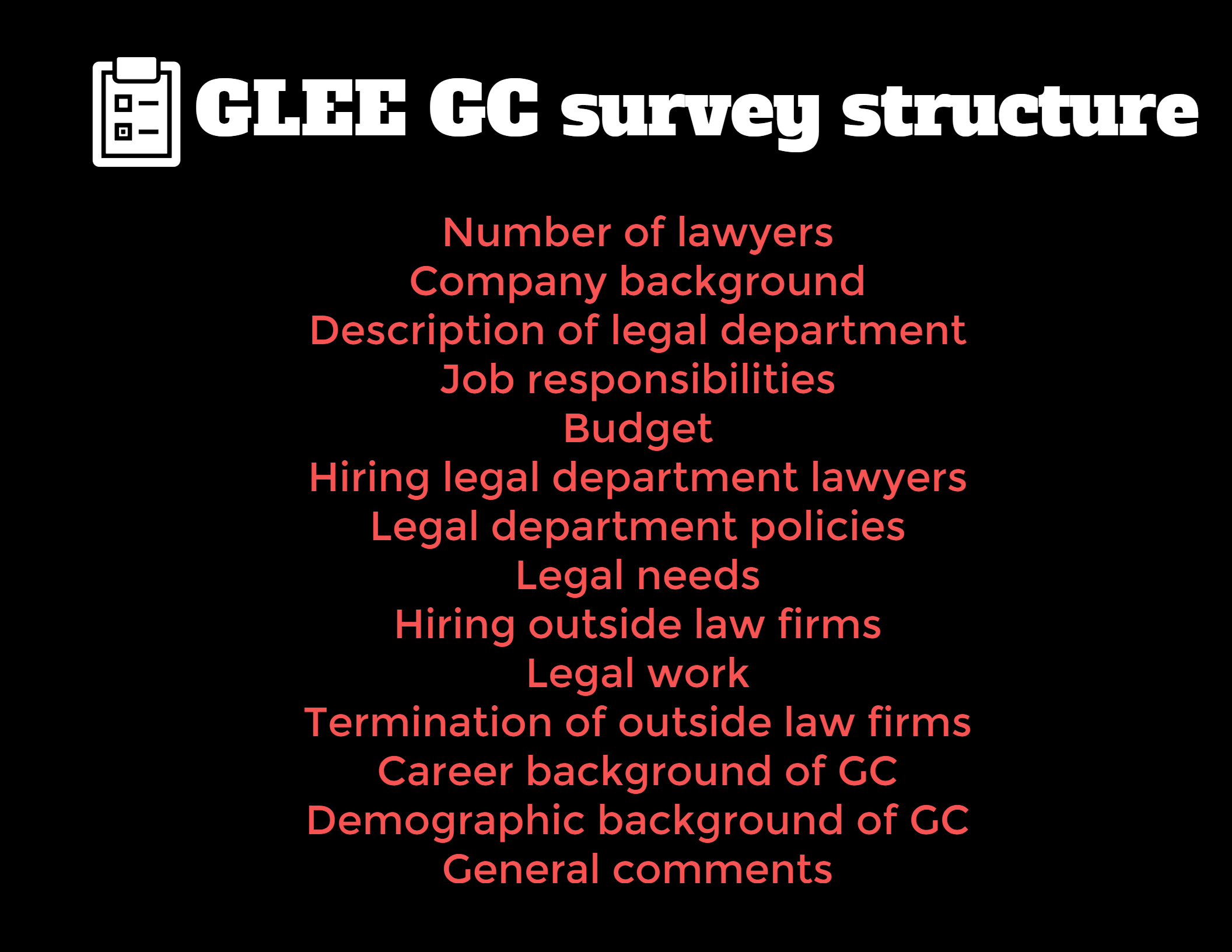
The survey questionnaires from India and Brazil were primarily completed from 2014 to 2015, and most participants responded online. (A portion of the Indian sample completed the survey as part of an in-person interview with a research team.) In India, survey respondents worked at companies representing about 27 percent of the market capitalization of publicly traded Indian firms. In Brazil, survey respondents tended to come from the largest Brazilian companies, and data analysis is continuing in order to provide a more refined picture of the sample.
Analysis is currently taking place examining the evolution of in-house legal departments in these jurisdictions based on specific corporate structures and industries. For instance, state-owned enterprises (SOEs) are still more common in India and Brazil than in most Western countries and may impact legal department functions and organizations. Moreover, there are potential differences in how the legal departments of closely held versus widely dispersed companies operate. And there are questions of industry, particularly in the context of the regulatory burdens of particular industries (e.g., a heavily regulated industry), as well as whether a company is more export or domestic focused.
More information on the methodologies and corporate structures and industries will be available here upon final publication of the results.
The data
As outlined in the lead article, a central feature of the in-house counsel movement in the United States has been a shift in the credentials and demographics of GCs and those who work in internal legal departments. However, as is documented below, evidence from research in India and Brazil reveals important contrasts both with the United States as well as between India and Brazil. Below we examine key areas from the survey, comparing and contrasting the results between the countries.
Demographic profiles of GCs
Overall, the data indicates that Indian GCs tend to be slightly older (age 48) as compared to Brazilian GCs (age 40). In addition, a higher percentage of Indian GCs in the sample—89 percent—are male as compared to Brazilian GCs (75 percent). This corresponds with anecdotal evidence from Brazil, where women GCs have formed an organization called General Counsel with Skirts dedicated to pushing companies and law firms to hire and promote more female lawyers. By comparison, in the United States, 2015 data from the Minority Corporate Counsel Association found that just under 75 percent of Fortune 500 GCs are men—almost identical to the percentage reported by Brazilian survey respondents. A similar survey found that the average age of respondents was 50, making American GCs slightly older than both the Indian and Brazilian averages.
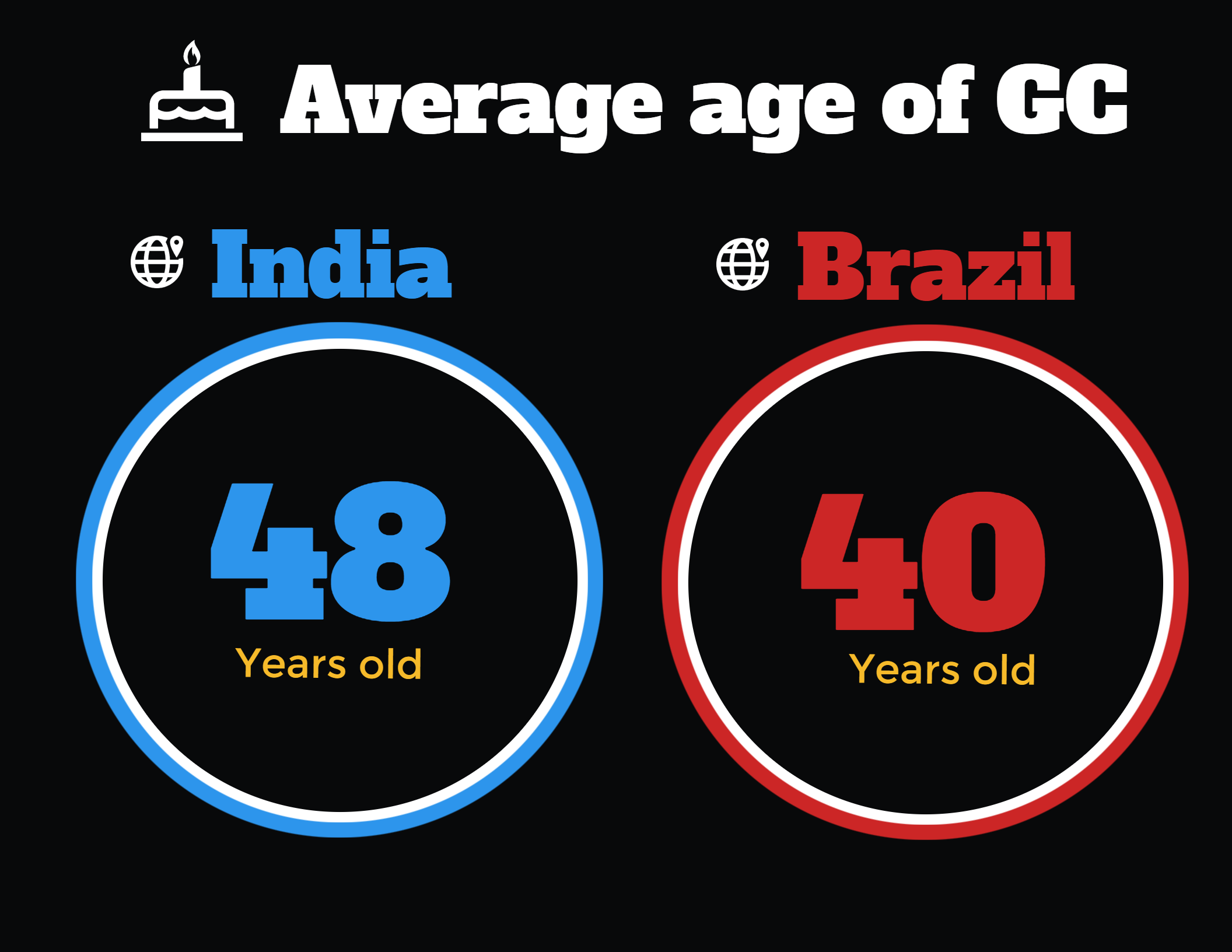
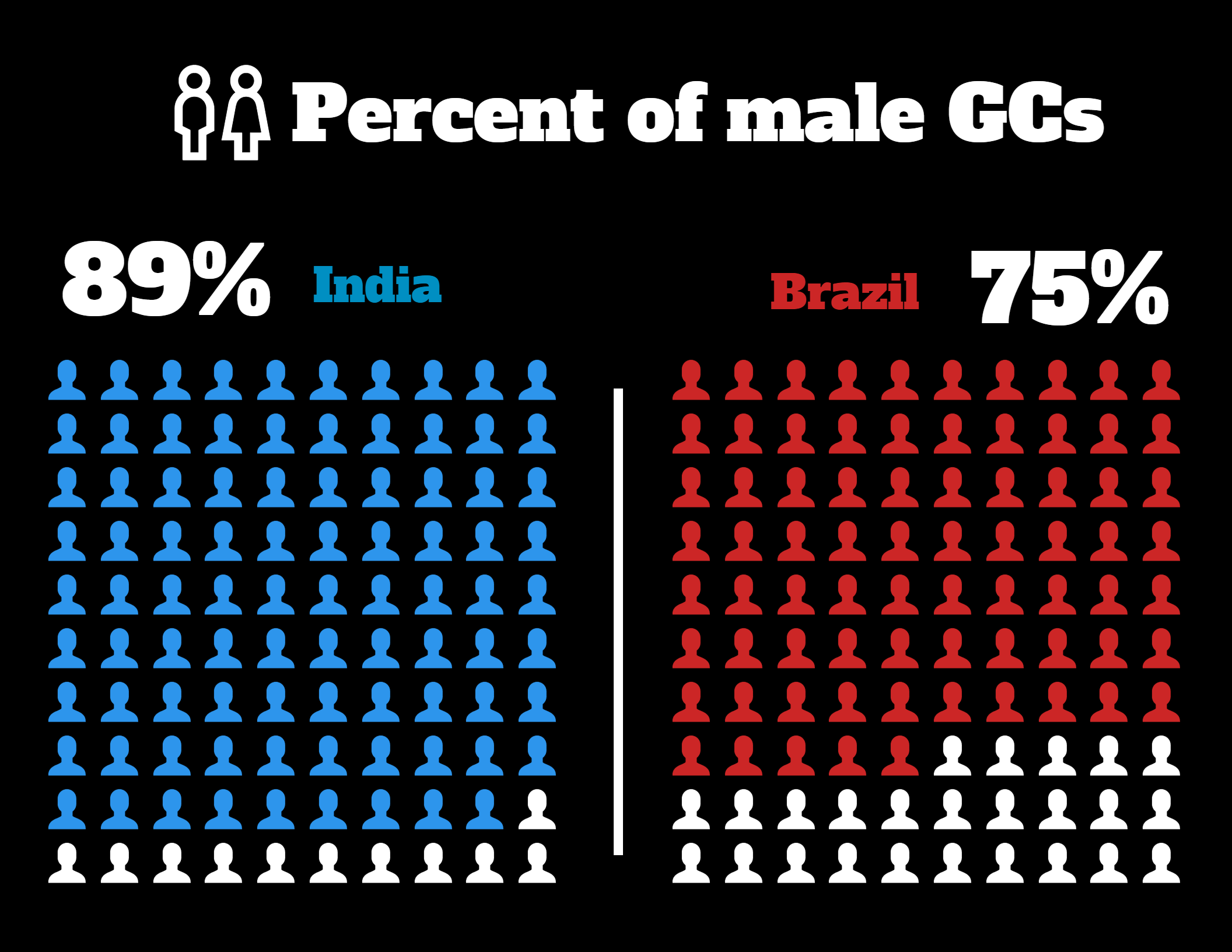
On average there has been a general upgrading in the credentials and experience of in-house lawyers in both India and Brazil. In both countries, GCs tend to come from relatively advantaged families. The fact that GCs tend to have educated parents is not surprising given the status and income associated with these positions. Interestingly, a significant number—more than 50 percent in India—of GCs come from “nonlawyer” families. With respect to their own credentials, there is a slight difference between Indian and Brazilian GCs, with a larger percentage of Indian GCs having obtained an LLM.

When it comes to bar membership, there are important differences between Indian and Brazilian GCs. Only 54 percent of the Indian GCs in the sample report having ever been members of the Indian bar, with only a small minority (4 percent) holding membership in a foreign bar. This last statistic was particularly surprising, since almost a quarter of the respondents (24 percent) have an LLM from a foreign law school, which presumably gave them the chance to sit for a foreign bar. It is worth stressing that the Indian in-house lawyers are required to surrender their bar credentials upon joining a company.
Collectively, this pattern implies that while educational credentials—including those from foreign law schools—are valuable, bar membership seems to be less so. This also suggests that the push for professional standing within the organized bar, which characterizes the in-house counsel movement in the United States and Brazil (where 89 percent of respondents report being members/former members of the bar), may be less important in India—at least for the time being.
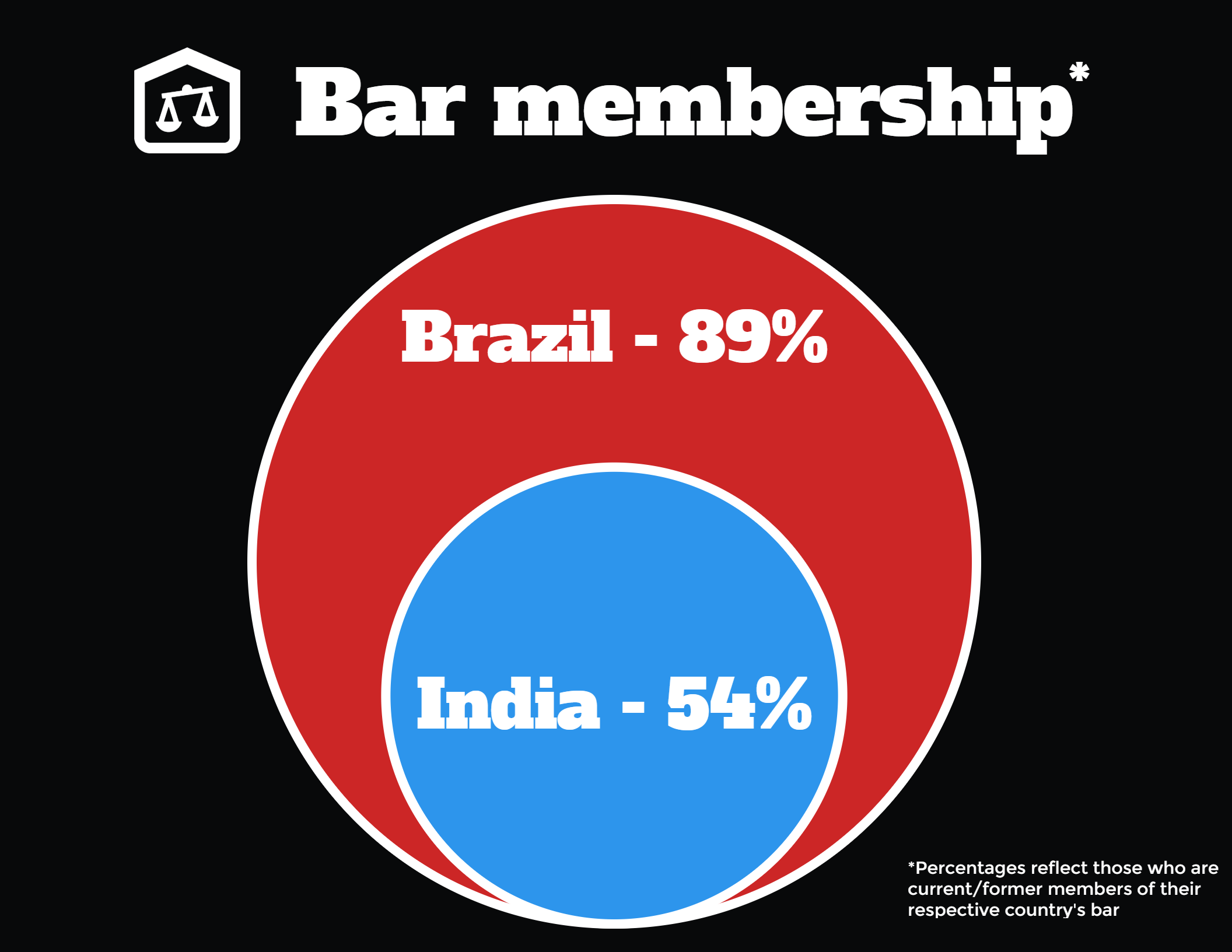
Career history of GCs
Just as Indian GCs tend to be older than their Brazilian counterparts, they also tend to have longer tenures both with their respective companies as well as in the GC role. On average, Indian GCs have been at their companies for almost 10 years, compared to just around five for Brazilian GCs. Indian GCs in our sample also report being in their current role as GC for almost twice as long as their Brazilian counterparts—5.35 years to 2.44 years respectively. By comparison, the Harvard Law School Center on the Legal Profession’s 2006–2007 Corporate Purchasing Project (CPP) (see “The In-House Counsel Movement”) determined that the majority of U.S. GCs in the sample averaged 4.6 years in their current role as GC and nearly 10 years in their current company. Thus, it seems that Brazilian GCs may be unique, at least among the three countries, in having relatively short tenures.
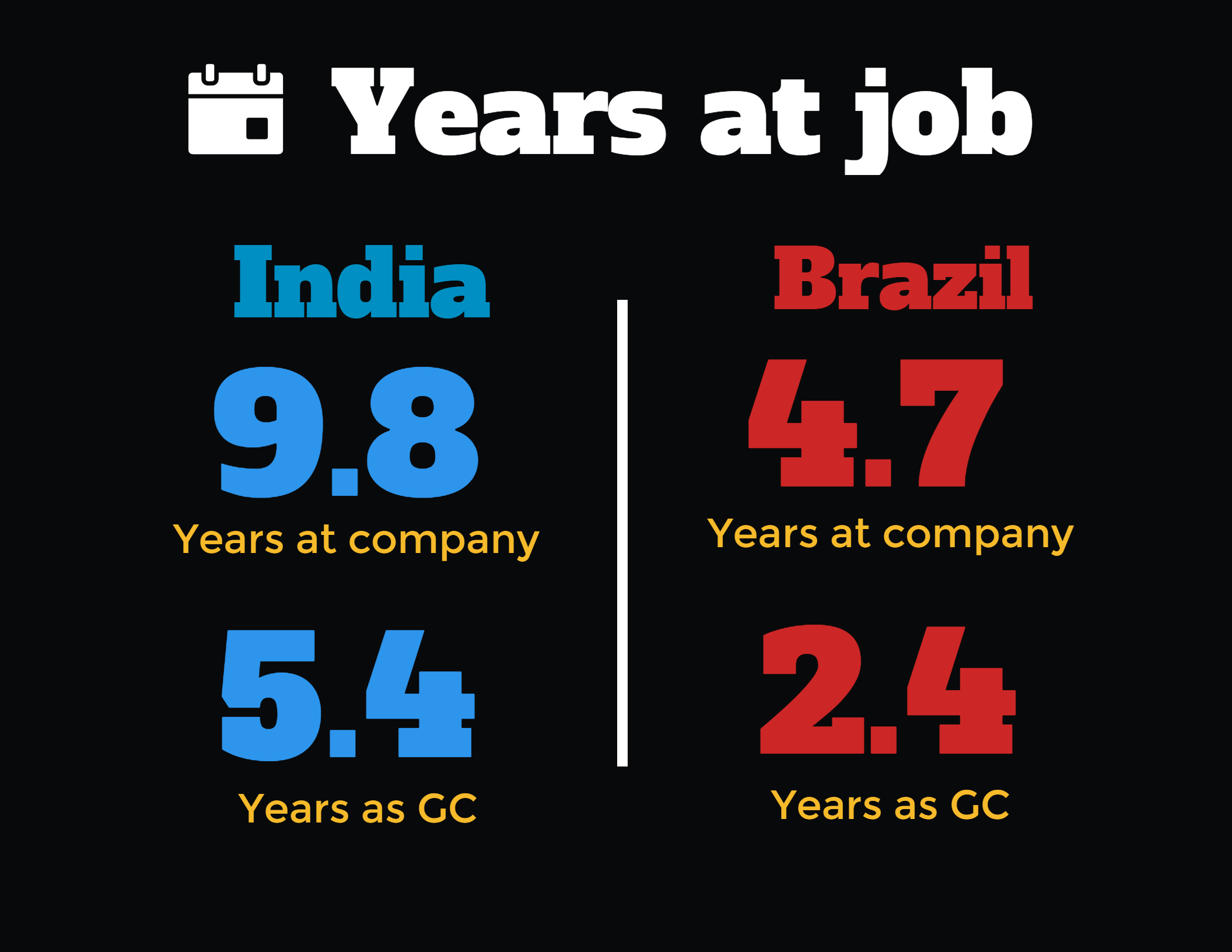
Significantly, in both India and Brazil, the GCs in the sample had relatively little experience outside of the in-house world before assuming their current positions. As displayed above, almost 60 percent of the GCs in the sample from both jurisdictions came to their current company from another company. However, a sharp difference arises between India and Brazil when it comes to the career paths of the remaining GCs. A significant percentage of Brazilian GCs—32 percent—had worked in a law firm before becoming GCs. In India, only 11 percent of GCs fell into that category. This difference suggests that law firm experience may be more valuable to Brazilian companies than to Indian companies. It may also reflect the fact that the more-modern corporate law firms in India have a shorter history than in Brazil.
Alternatively, in India, more than a quarter of respondents note that they came to their current position from an “other” category, largely from the government, compared to only 10 percent of Brazilian respondents. As we will return to below, there is strong evidence that Indian GCs are more involved in the policy-making process than their Brazilian counterparts. The fact that a significant portion of them report previous experience within government provides a measure of explanation for this phenomenon.

Legal department profiles
All over the world, the size and structure of legal departments have grown substantially over the past two decades. As in the United States, the size of legal departments (in country) in India and Brazil vary, with Indian legal departments tending to be larger in size (almost 30 lawyers on average) than Brazilian departments (18 lawyers on average). Reflective of the important role of foreign multinational companies in each of the jurisdictions, both Indian and Brazilian GCs in the sample report high numbers of in-house lawyers outside of the country.
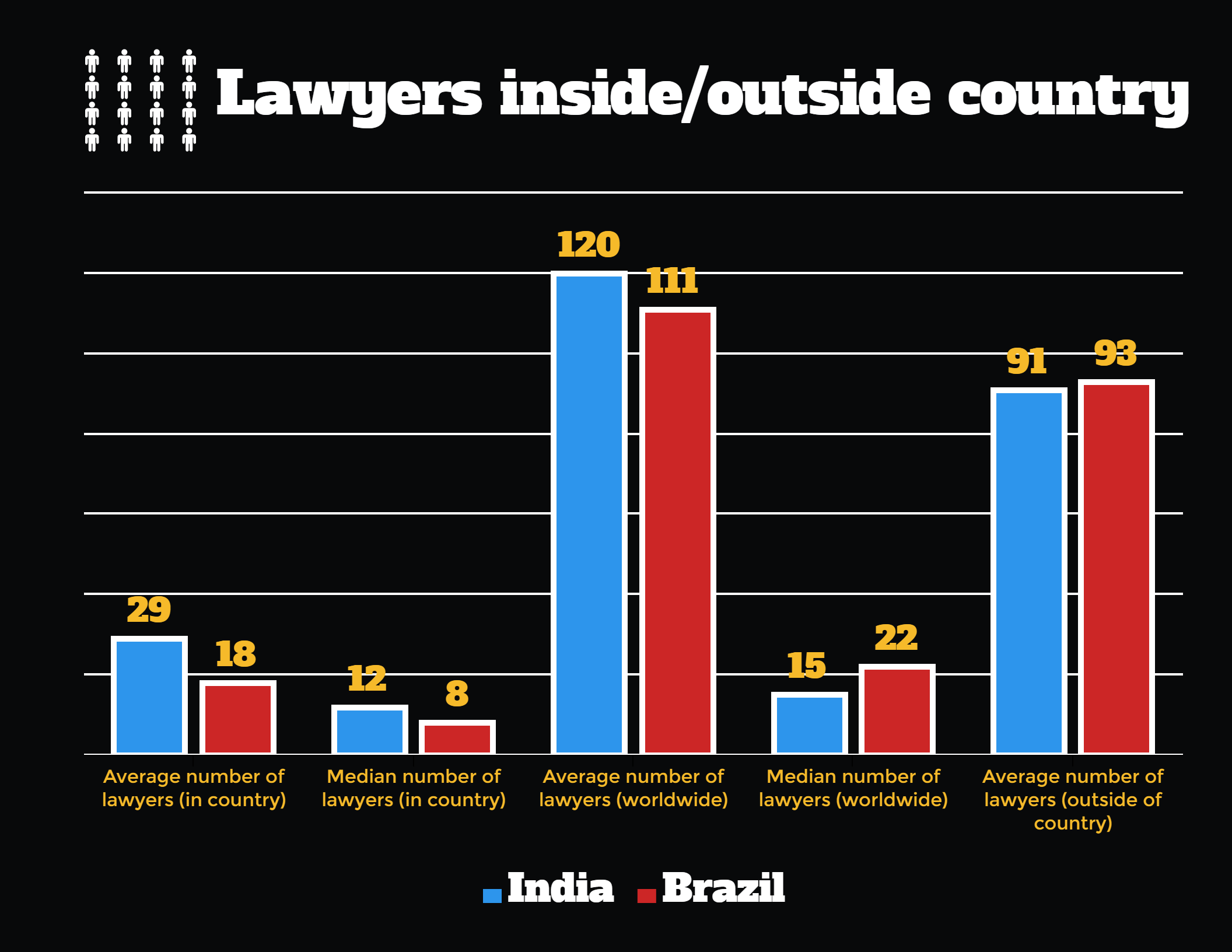
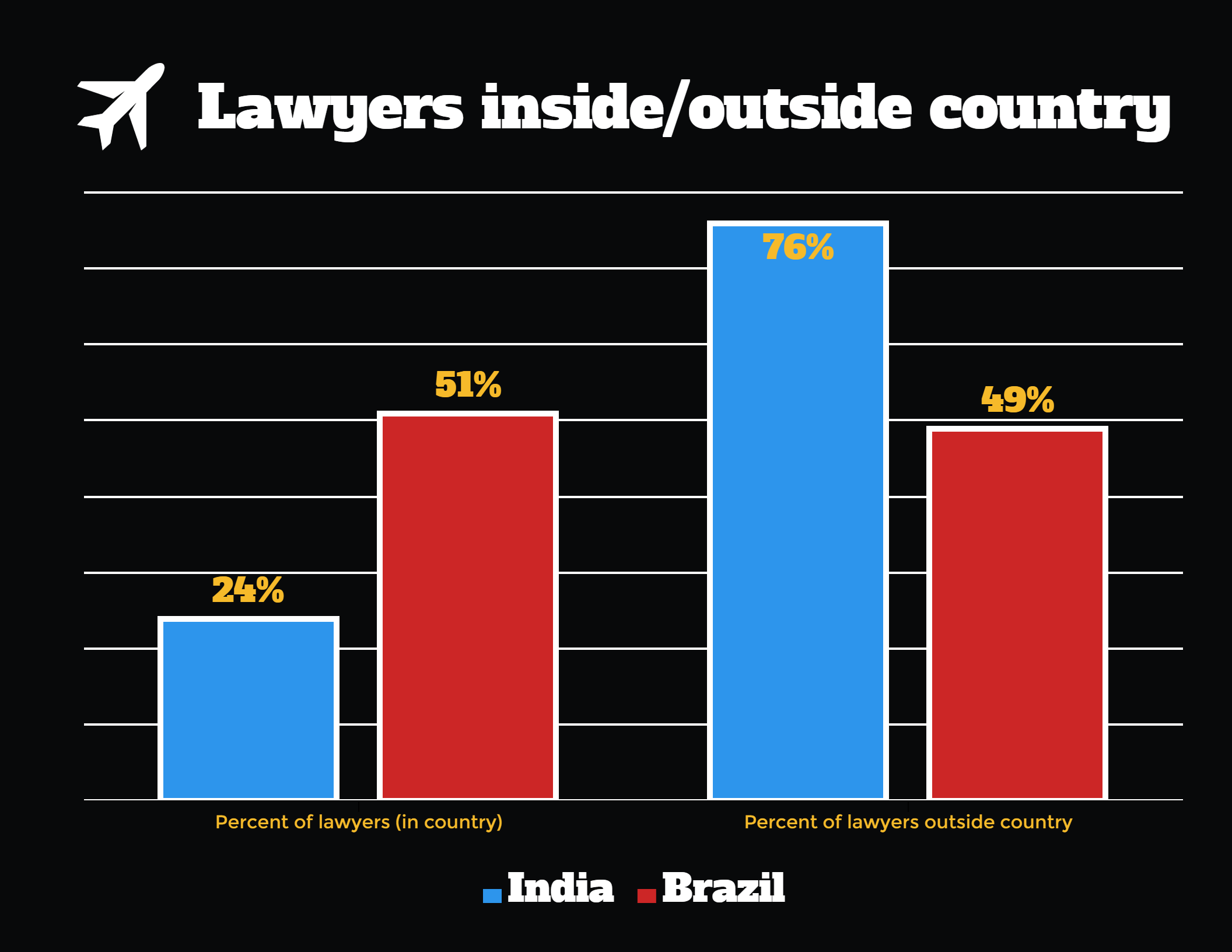
Just as there is a higher average percentage of women GCs in our sample from Brazil than in India, Brazilian legal departments are also more feminized than Indian in-house departments. In the sample, on average more than half—57 percent—of Brazilian lawyers working in-house are women. That number drops to just 32 percent for India. These numbers support the previously mentioned point that Brazil is witnessing a greater feminization of the in-house ranks than India. The Indian case is particularly interesting in that it runs contrary to the typical story that holds that in-house offices are more gender equal than law firms. In India, the situation seems to be reversed: Recent studies have shown that Indian law firms are actually viewed as bastions of relative gender equality.
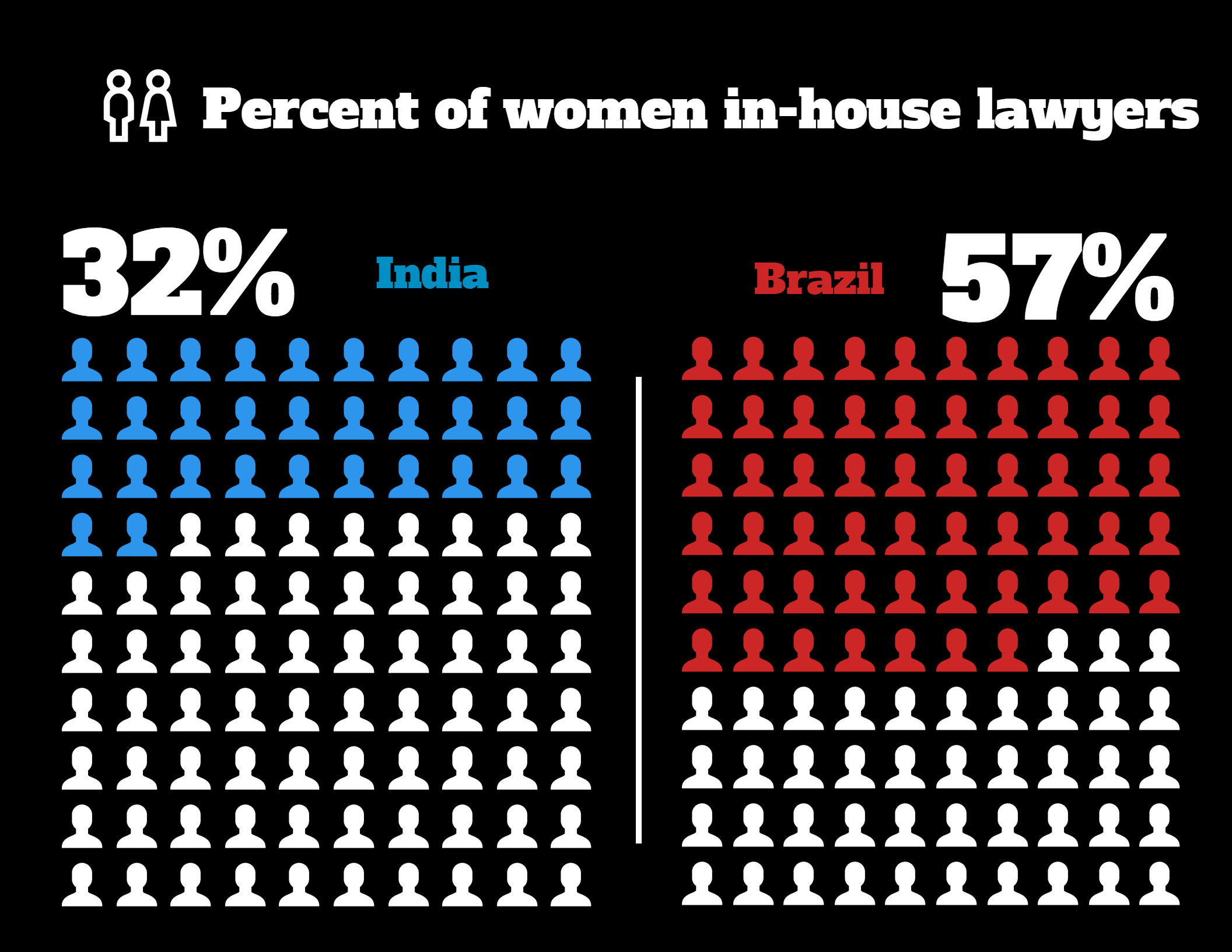
Job responsibilities of the general counsel
As the size of in-house departments has grown, there seems to have also been a corresponding growth in the GC’s internal influence. For instance, the evidence suggests that prior to 2000 most GCs in India reported to the CFO, confirming their subordinate status in a company’s central corporate function. Recently, however, GCs have moved away from this reporting structure in both India and Brazil. As indicated above, almost half of Indian and Brazilian GCs in the sample report directly to the CEO. (In the United States, this number is significantly higher—almost 90 percent—according the Center’s CPP data.) To the extent that reporting relationships are a good indicator of importance, the GC has moved up in the corporate hierarchy in both India and Brazil.
It is worth noting that the second most common reporting relationship noted by respondents is that with the global (or regional) GC—17 percent of Indian respondents and 23 percent in Brazil. This reporting relationship is likely more prevalent among Indian and Brazilian GCs of foreign multinationals. One critical question going forward is whether the career path for these GCs remains “in country,” such that the next step in their career would be to become the Indian or Brazilian CEO of a foreign multinational, or whether the career ladder would instead lead them up the legal ranks to their company’s home office as the global GC (see “General Counsel in Practice”).

Examining the relationships between the GC and other internal players provides further evidence regarding the spread of the inside counsel revolution and the increased stature and responsibilities of Indian and Brazilian GCs within the overall corporate structure. As indicated above, approximately 50 percent of all Indian and Brazilian GC respondents report that all lawyers within the company (or in the case of a foreign multinational, within the Indian or Brazilian office) report to them as opposed to the CFO or another corporate officer. Significantly, 31 percent of Indian GCs and 27 percent of Brazilian GCs say other departments, such as human resources and/or compliance, also report to them, a clear example of the expanding role and power of the GC office. Moreover, the majority of GCs in the sample across both countries report playing a key role in senior leadership decisions, counseling the CEO, and advising the board. Virtually all GCs in both countries note that their responsibilities in these areas have increased over the past three years, presenting a strong indicator of the global spread of the inside counsel revolution.
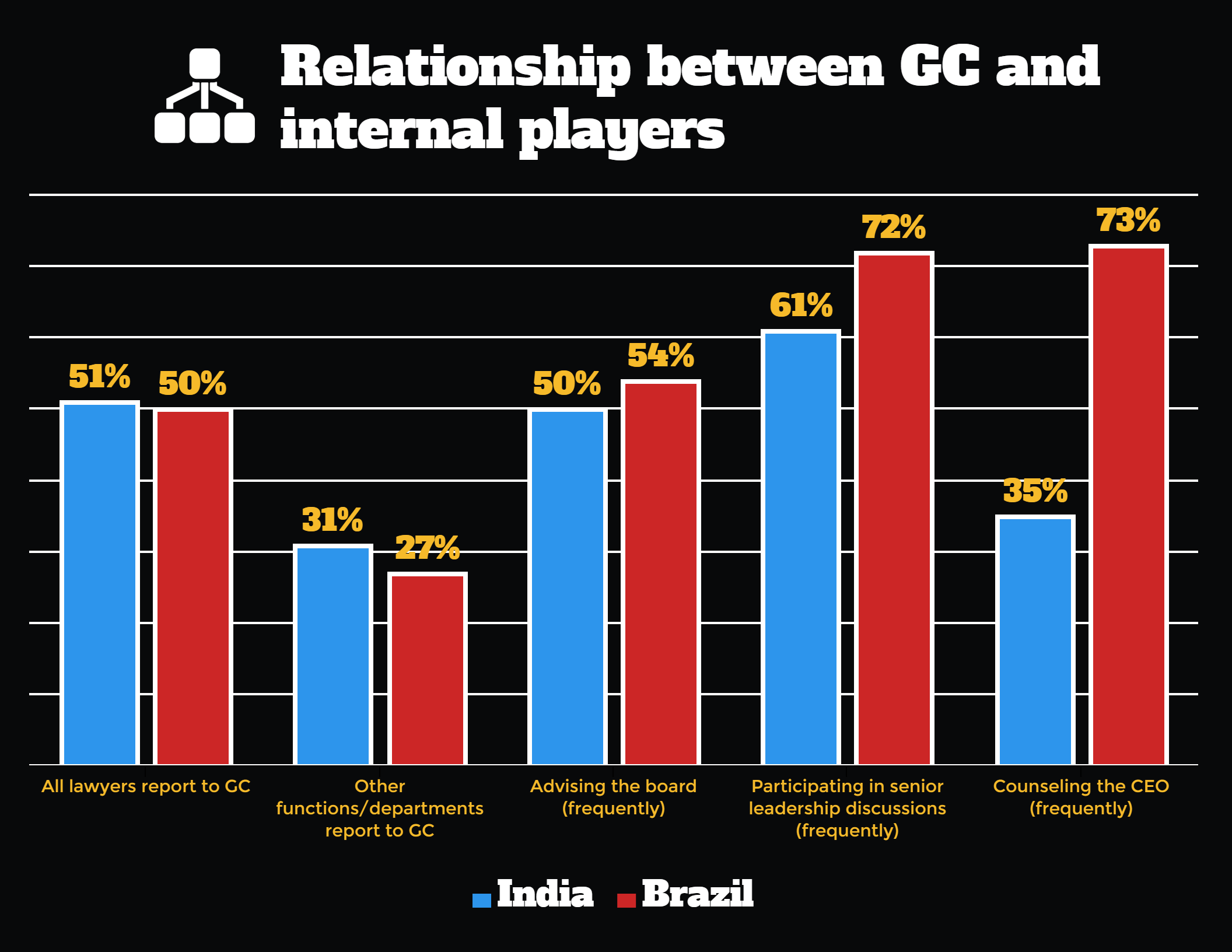
With expanded influence in their companies, one anticipates that Indian and Brazilian GCs would also see their work portfolios correspondingly increase. The above chart provides details on the job responsibilities and requirements for GCs from the sample. Consistent with a fundamental tenet of the in-house counsel movement that holds that the GC should have control over the company’s legal needs, virtually all respondents in the sample in both India and Brazil indicate that they have primary responsibility for managing the legal department staff and hiring and managing outside lawyers. Closely following these core managerial duties, more than 80 percent of respondents in both jurisdictions indicate that they are primarily responsible for contract design and negotiation, suggesting that Indian GCs also continue to have direct responsibility for substantive legal work.
Upward of 80 percent of GC respondents in India—and more than 90 percent in Brazil—indicate that they have primary responsibility for compliance in their company. Insofar as compliance has been the CFO’s responsibility in many companies, particularly in India, the fact that the overwhelming majority of GCs now have primary responsibility for this function indicates the shifting balance of power between these two positions. Outside of core legal and compliance-related duties, there is less consensus among respondents, as well as more country variation, about the areas for which GCs are primarily responsible.

Role in public policy
The chart below offers a perspective on the role of the GC in public policy and government relations, which, as the David B. Wilkins pointed out in “The In-House Counsel Movement,” is an area associated with the inside counsel revolution. Similar numbers of Indian and Brazilian respondents report being frequently engaged with agency offices and participating in trade group organizations. Indian GCs report being slightly more engaged in commenting on pending legislation than their Brazilian counterparts. As a case in point, Bharat Vasani, the GC of the Tata Group, was a key player in the drafting of the Indian company and competition law. Indian respondents are also more likely to be frequently engaged in speaking out on public policy concerns and debates over the regulation of the legal profession. It is worth noting that Brazilian GCs report having had their activities in these areas increase at a much higher rate over the past three years than those in India, perhaps indicating a catch-up effect.
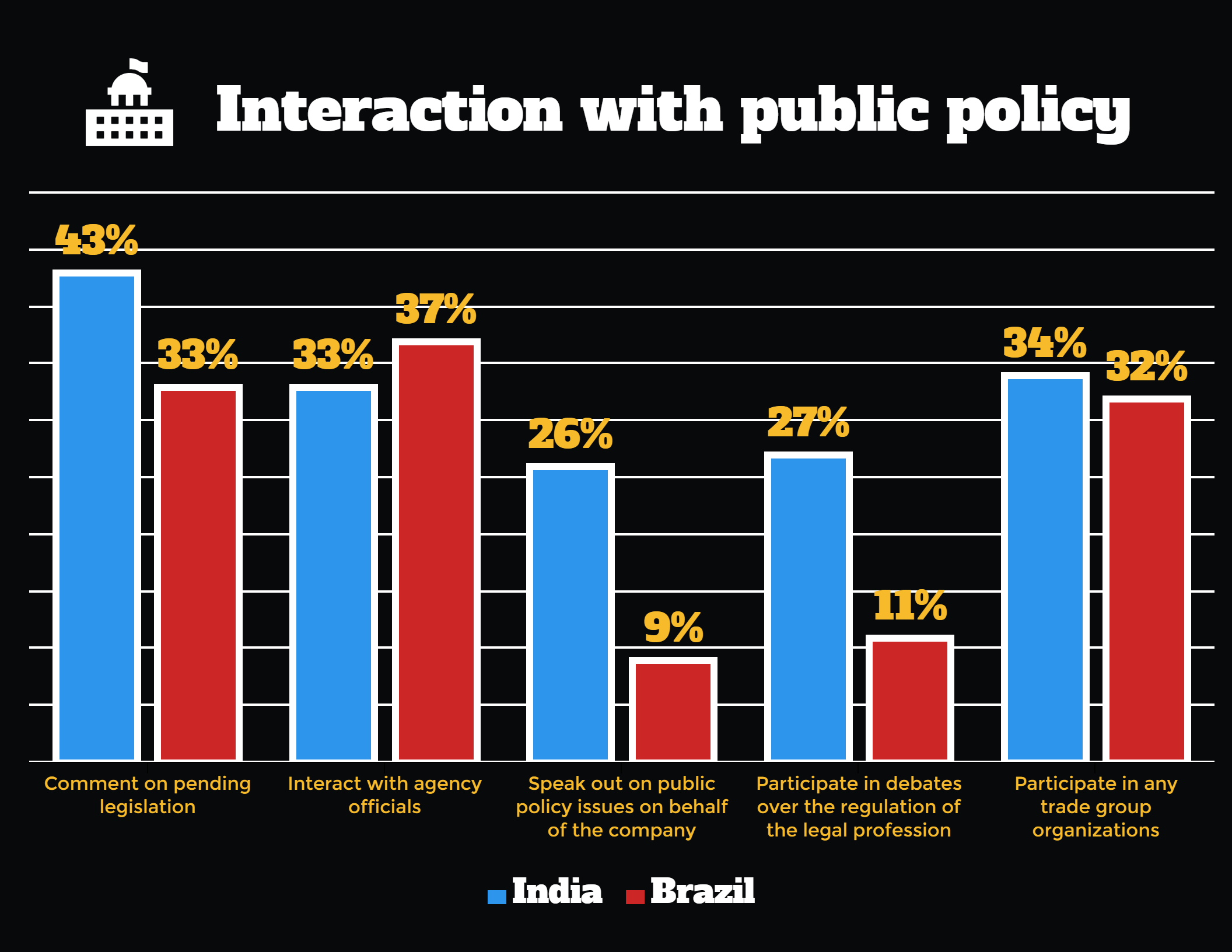
Relationships with outside law firms
The changing dynamic between in-house departments and outside law firms has animated much of the discussion on the in-house counsel revolution. As a result, the survey asked respondents a number of questions about this relationship. One of the most critical issues concerns the purchase of outside legal services and areas of work. Starting with India, in looking at the respondents’ top five areas of work, responses indicate that GCs tend to keep in-house the majority of the commercial contracts and regulatory compliance work (both 51 to 60 percent of the work), whereas civil liability/arbitration, consumer issues, and M&A are largely sourced to outside providers (61 to 70 percent for all three). This is mostly true for Brazilian respondents, who note that the majority of the commercial contracts and regulatory compliance work is kept in-house (70 to 80 percent and 50 to 60 percent respectively). With respect to civil liability/arbitration, consumer issues, and M&A, Brazilian respondents generally mirror Indian respondents, showing a greater propensity to send work to outside providers.
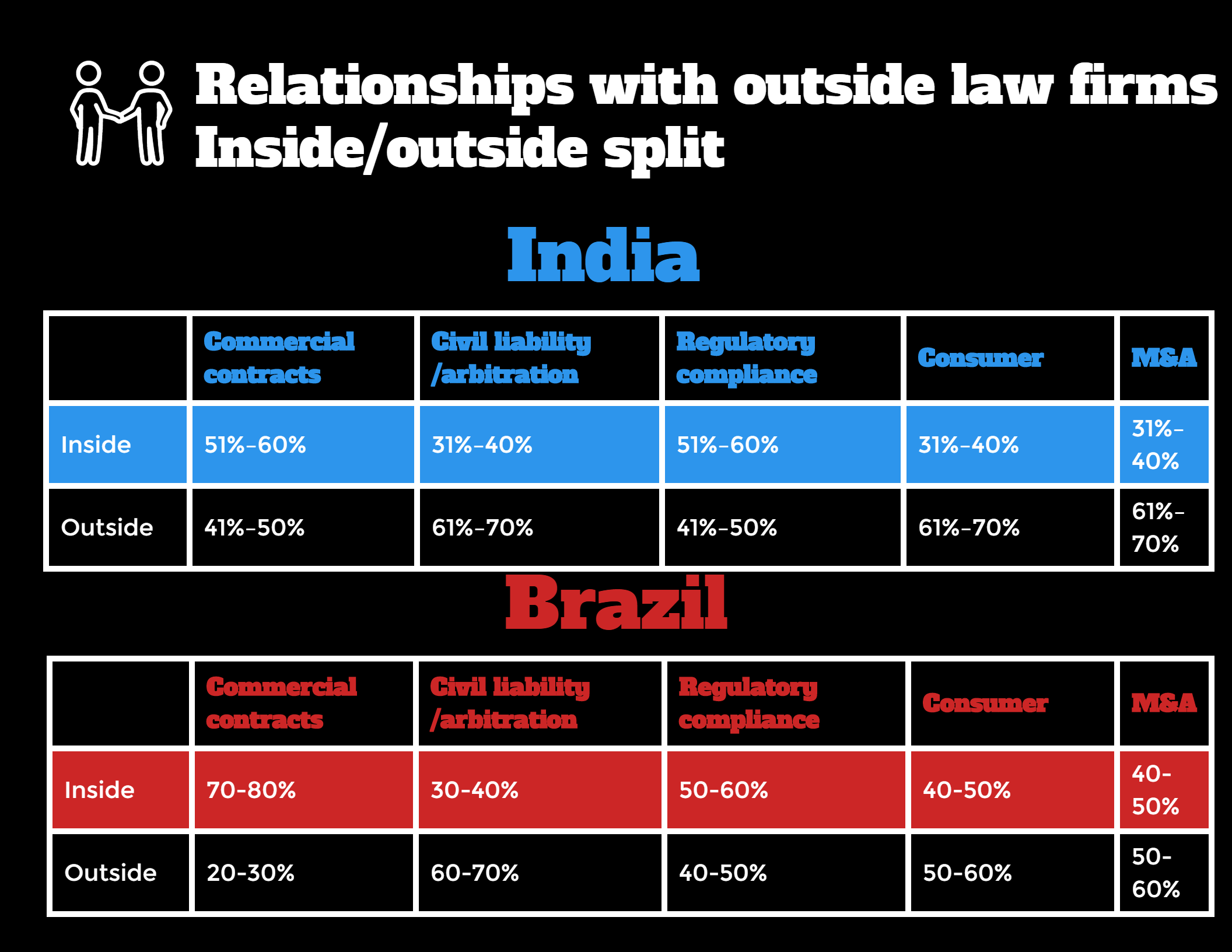
The survey then probed what portion of outside legal expenditures by area of law is fulfilled by domestic law firms, foreign law firms, and other types of firms (e.g., outsourcing entities, compliance specialists, accounting firms). This reveals a number of interesting points. First, in both India and Brazil, the lion’s share of all legal work contracted out is being sent to domestic law firms. Second, notwithstanding that domestic law firms do the majority of outside legal work in both jurisdictions, India sends work to foreign firms across all five major legal practice areas at a much higher rate than Brazilian companies. Finally, Indian respondents report utilizing other providers—such as outsourcing entities, compliance specialists, and/or accounting firms—at significantly higher rates than Brazilian companies. Indeed, apart from regulatory issues, Brazilian companies report hardly ever using non-law-firm providers. This is, however, not altogether surprising given the important role India has played, particularly in relation to Western companies, in the development of LPOs and other outsourcing endeavors. There is no reason to think that Indian companies would also not take advantage of such local resources.
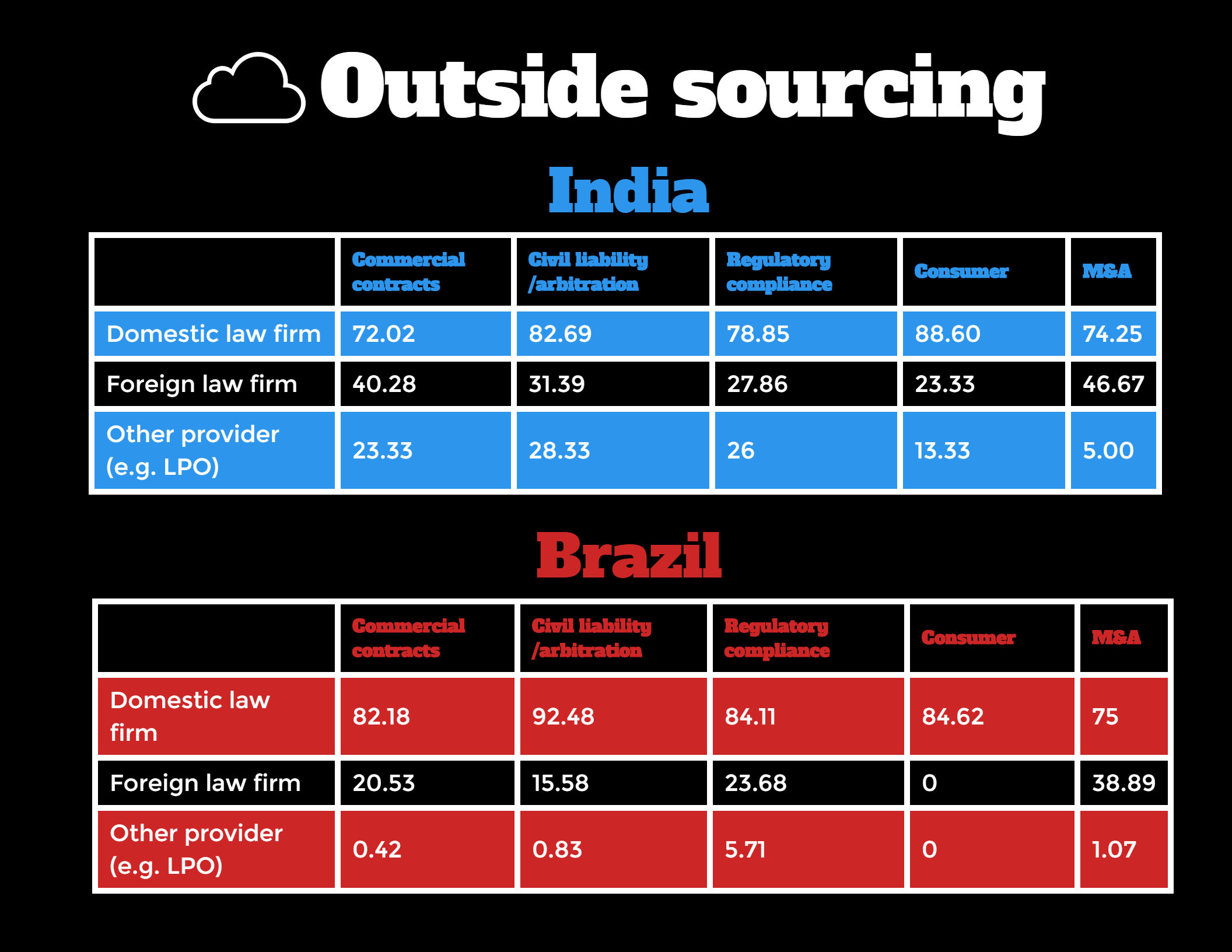
Hiring outside law firms
In light of the importance of outside legal services, the survey also inquired how decisions to purchase such services are made. According to the data, the majority of all surveyed companies in both India and Brazil use preferred provider lists for domestic hiring (74 percent in India, 68 percent in Brazil). Consistent with the tenets of the in-house counsel movement, the overwhelming majority of the respondents in both India and Brazil report that they are primarily responsible for putting the list together (91 percent of Indian GC respondents, 92 percent of Brazilian respondents). Moreover, consistent with the story told in the United States, survey respondents from both countries also report that a healthy majority—although admittedly not all—of the company’s legal work goes to law firms on the lists. And, again consistent with the convergence trends seen in the U.S. market (see “Corporate Purchasing Project”), the number of firms on the list is relatively small—just under 11 in India and nine in Brazil. (Indeed, on a global scale, Shell recently announced it was slashing the number of firms on its global list from 250 to just six [see “In the News”].)
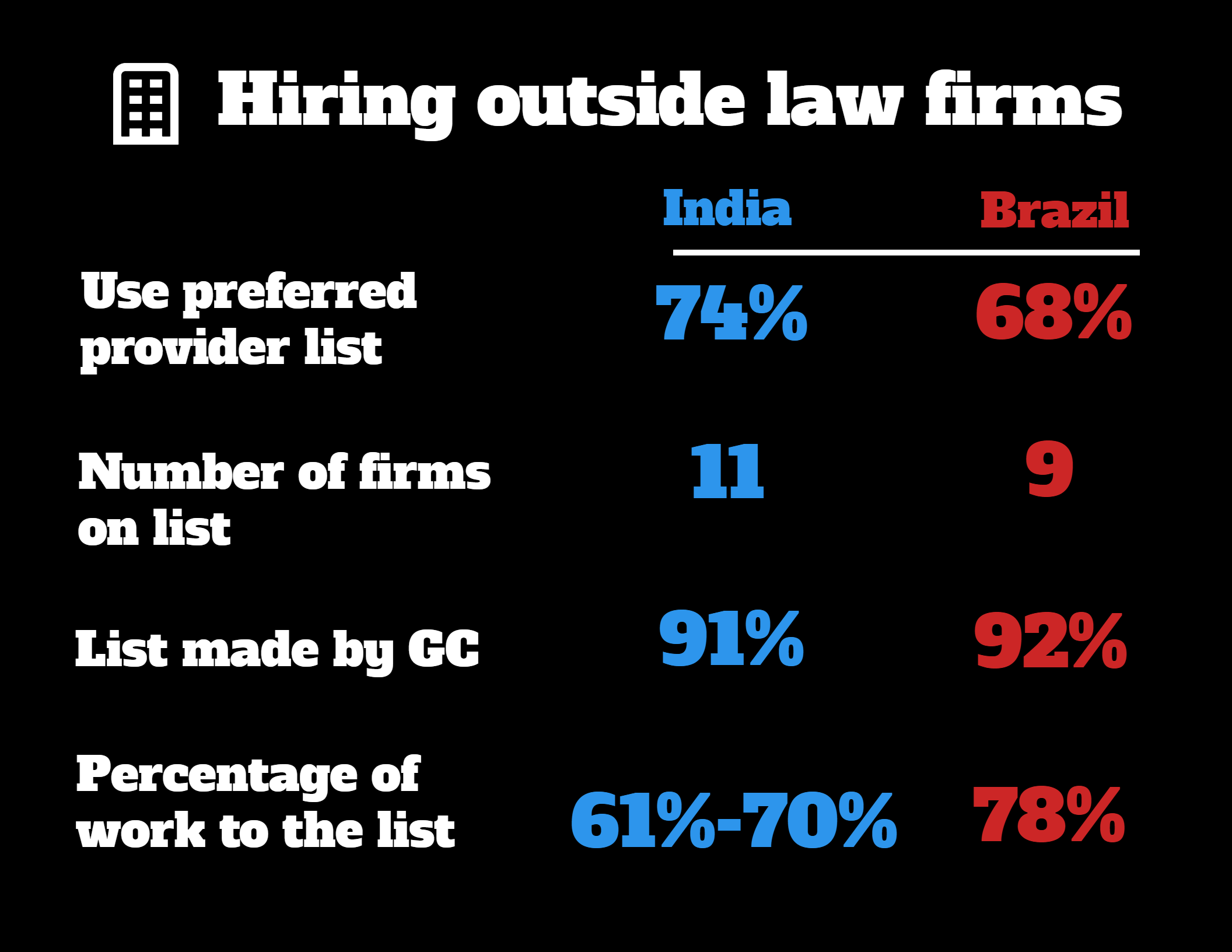
Terminating or adjusting relationships with outside legal service providers
In addition to asking about hiring, the survey also queried respondents about when they terminate the law firms they are using for very significant work. As indicated by David B. Wilkins in the lead story, one of the hallmarks of the in-house counsel movement in the United States has been the claim that GCs have “broken up” the long-standing relationships between companies and outside law firms by frequently switching legal providers to obtain the best service and price. However, as the CPP discovered (see “In-House Counsel Movement“), the reality is more complex. Although GCs have moved away from the bilateral monopoly relationships that companies traditionally had with their top outside law firms, this does not mean they are switching important law firm relationships as frequently as a “spot contracting” analogy implies. Instead, CPP data indicates that important law firm relationships change relatively infrequently. Rather than terminating the relationship altogether, GCs use the strategy of reducing work—often to the entire team or department where the offending lawyer worked—when they are unsatisfied with either the quality or the price of the services received.
Survey data in India shows a similar pattern, but one where firm-level relationships continue to play a larger role. As in the United States, the vast majority of companies in India rarely terminate important law firm relationships. Indeed, 62 percent of GCs surveyed report that they did not do so at all between 2009 and 2015, with another 29 percent having done so only once or twice during this period. These percentages are significantly higher than in the United States, where only 31 percent of companies had not terminated a significant law firm relationship and 48 percent had done so once or twice during a comparable period. The fact that less than 10 percent of respondents in India claim that they terminate important law firm relationships relatively frequently—compared to the 21 percent in the U.S. sample who report doing so—underscores how stable these relationships still are in India.
In looking at law firm terminations in Brazil, the picture more closely mirrors the United States than India. Overall, 53 percent of Brazilian respondents report having never terminated a law firm relationship in the past three years, which is significantly lower than in India (62 percent) and in line with the United States (31 percent). 31 percent of Brazilian GCs report having terminated a relationship once or twice, with just 14 percent reporting a few times, and a very small minority reporting many times. Viewed together, this points to relatively stable law firm relationships in Brazil (similar to the United States), and much more stable relationships than in India.
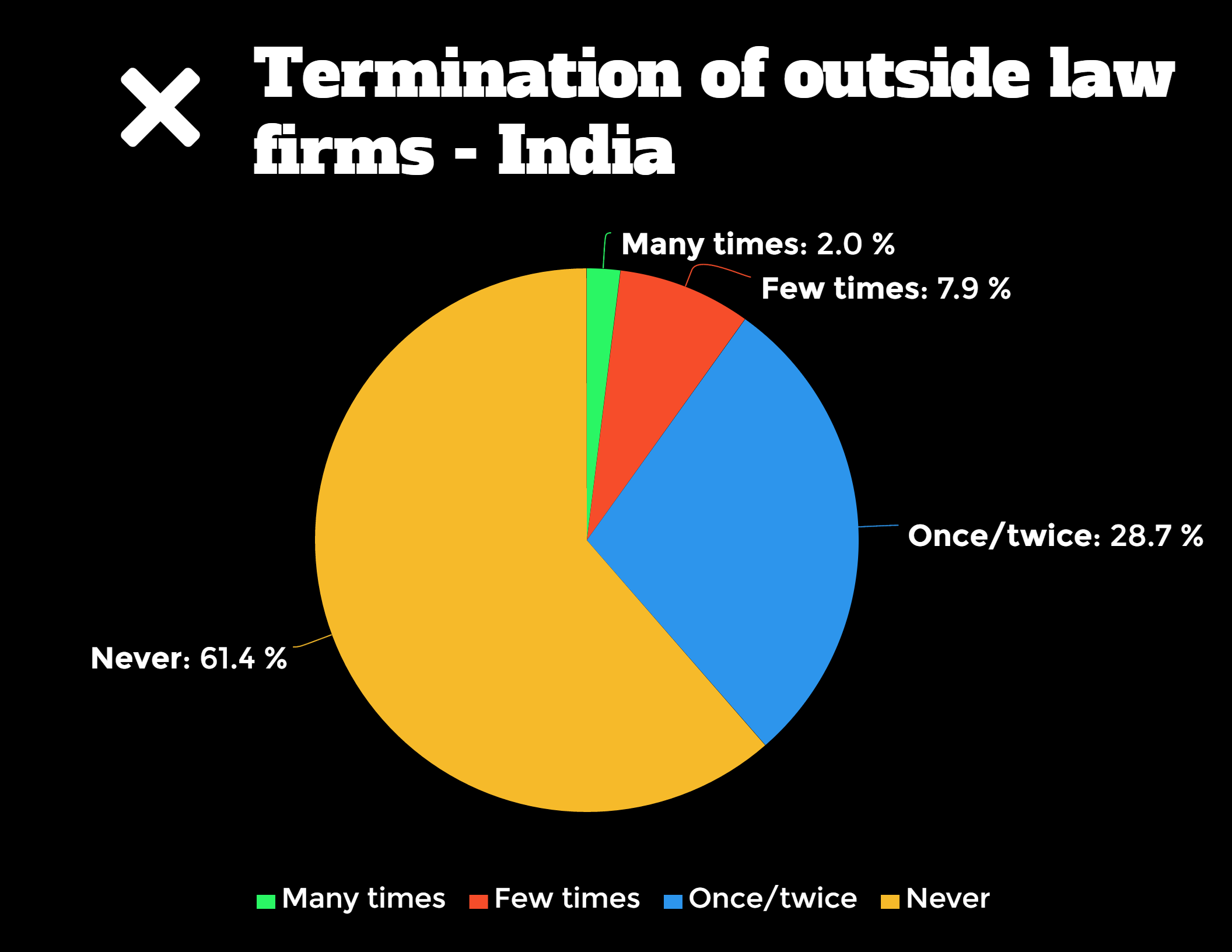
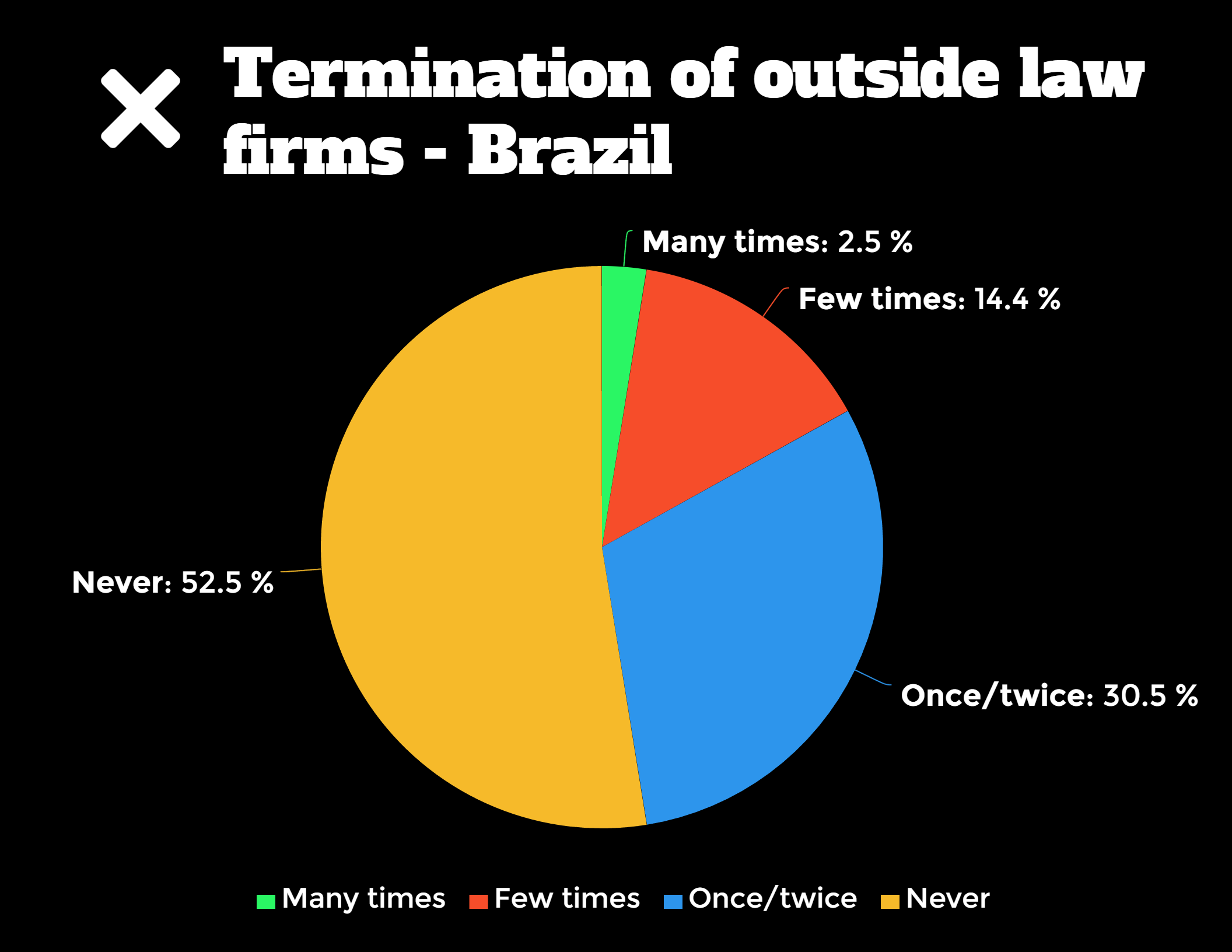
What should one make of this?
The findings presented in this story and summarized in the six metrics of change table (above) provide strong preliminary evidence of the in-house counsel movement’s expansion to the important emerging economies of India and Brazil. Across all six metrics, the survey data demonstrates that GCs and in-house legal departments are becoming increasingly powerful players, both in their overall corporate structures and in the legal profession as a whole. In ways that were largely unthinkable as little as 25 years ago, in-house counsel are becoming powerful players in the legal services markets in India and Brazil, largely mirroring the story that unfolded in the United States and later in the United Kingdom.
At the same time, however, it must be said that the unfolding story may not be one of simple diffusion or mimicking: Indian and Brazilian in-house departments are not simply adopting the in-house counsel movement in an unadulterated U.S. form. Rather, the survey data suggests country-specific differences with respect to the precise contours of the inside counsel movement—differences likely driven by factors such as the jurisdiction’s overall economic condition, exposure to “the West,” the state of the legal profession, and other local factors. This means that the Indian and Brazilian experiences will not only differ from the U.S. model, but also from each other due to their unique historical, economic, political, and social circumstances. Just as Indian and Brazilian in-house departments do not directly mirror U.S. departments, they also do not conform to some standard model for emerging markets.
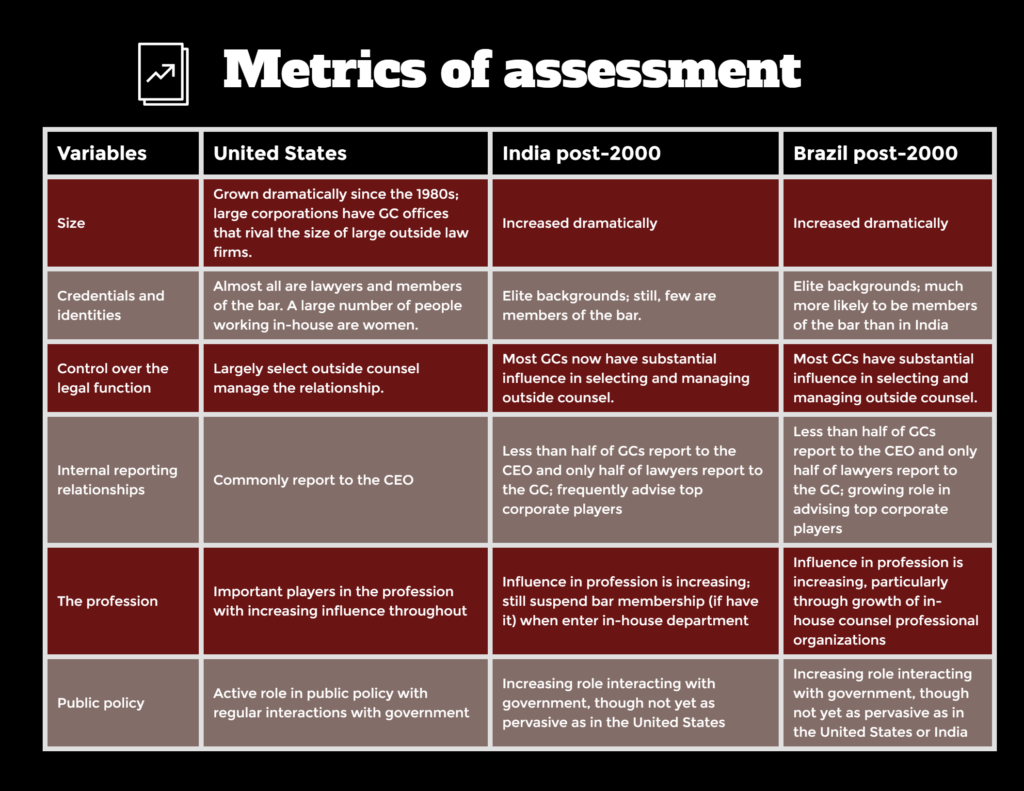
For example, the data shows that Indian GCs are less likely to terminate a law firm relationship than their counterparts in the United States or Brazil. On the one hand, this could be viewed as a sign of an underdeveloped GC office vis-à-vis law firms—and therein evidence against the inside counsel movement’s global expansion. On the other hand, by taking local contexts into consideration—contexts that include strong kinship and communal relationships between Indian companies and their outside counsel that do not exist in the United States or Brazil—it is much easier to allow for variation within the inside counsel movement’s global expansion.
In this respect, the question going forward is identifying how local contexts interact with the in-house counsel movement to produce unique versions of a global trend. More research must be done to determine when and where local contexts and the movement’s core tenets come into conflict, and therein how much variation may ultimately arise. What does seem clear, however, is that the in-house counsel movement’s global expansion will inevitably be shaped as much by the local as by any inherent characteristics the movement may have. Given this, rather than speaking of the globalization of the in-house counsel movement, it may be more appropriate to speak of its glocalization, a term that acknowledges both the movement’s expansionary force as well as the local pressures and contexts that condition its exact permutation in any specific jurisdiction.



